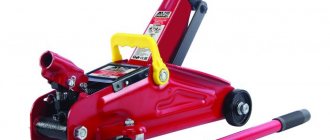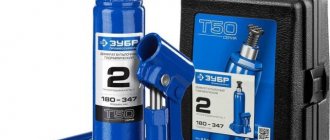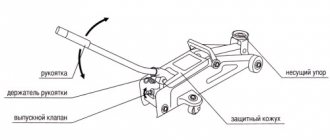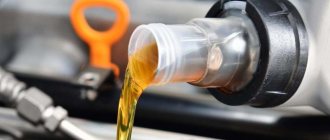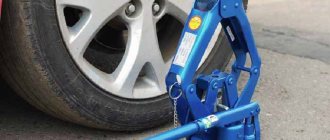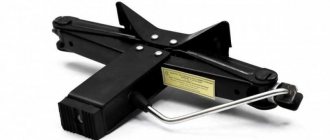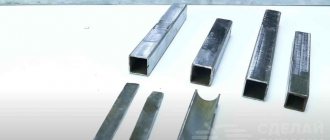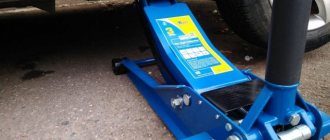Why doesn't the bottle jack work?
There is little oil in the tank, the rod does not rise to the height specified in the technical documentation.
To repair it yourself, we just need to add oil. Open the oil filler cap, fill it, then pump the jack, as described at the end of the article. Oil is leaking. It happens that oil leaks in places, rubber bands and seals, this is the first sign that a major repair needs to be made, all gaskets and seals need to be replaced, and a flush must be carried out. To repair a hydraulic bottle jack yourself, you will need a repair kit.
It sags under load. Occurs due to the air inside; one of the rubber bands or gaskets allows oil to pass through and instead air enters the working chamber, which tends to compress strongly under load. To eliminate the problem, it is recommended to repair the jack, change all gaskets and fill in new oil.
Flushing with cleaning fluid
Open the hole for filling. Drain all the oil into a prepared container. Next, add cleaning fluid. This procedure removes remaining oil and other dirt from the system. Next we follow the following algorithm of actions:
- Fill in the cleaning liquid.
- We move the lever, the liquid spreads throughout the system.
- Add fluid and pump the lever until the rod rises to the top position.
- Next, we open the check valve, the rod returns to its initial position, and part of the cleaning liquid is squeezed out of the system.
- If the squeezed out liquid is dirty, repeat the algorithm several times.
How to change a hinge at home
Now let’s talk about how to properly install silent blocks. Since the lever includes a rubber component, it is simply impossible to hammer the hinge (the rubber will dampen). At the service station, to carry out this kind of operation, a hydraulic press for silent blocks or a set for pressing out silent blocks is used. With their help, replacement is not difficult.
Press for pressing silent blocks
To carry out work in a garage, it is not necessary to purchase a special tool; the available tools will suffice:
- Bench vice;
- Percussion instrument (hammer);
- Metal attachment;
- Screwdrivers;
- File;
- Soap solution;
Read also: Templates for a wood router with your own hands
Using a regular vice and a piece of pipe of the required diameter, we get a pretty good press for pressing silent blocks in with our own hands.
Tool for replacing joints in your car yourself
But before you press the silent block into the lever, you still need to remove the worn element. And for this you can use several methods, but in any case the lever will have to be removed from the car. And then you can:
- Holding the lever in a vice and using a hammer with an adapter, knock out the hinge, first cutting off the rubber protruding beyond the edges of the lever eye (so that it does not create resistance);
- Use a vice. We take a piece of pipe (it should be larger in diameter than the silent block and its walls should rest against the eye). We put this segment on the hinge on one side, and on the other we use an attachment. We place this structure in a vice. When tightening the jaws of the vice, the attachment will push the element inside the pipe section;
- Fire out the silent block. Using an open fire (burner), we burn out the rubber component, and then knock out the remains with a hammer (this method is not recommended);
- Use a silent block remover (purchased or homemade);
Before pressing the silent blocks, its seat should be cleaned with a file to remove rust and remnants of the old hinge.
Now let’s talk about how to properly press silent blocks using a vice. Before starting work, it is advisable to make a chamfer on one side of the rubber component (cut it off with a knife), which will allow you to more accurately match the hinge with the eye.
You should also generously lubricate the seat and hinge with soap solution. It is not recommended to use lubricants based on petroleum products for this, as they have a negative effect on rubber.
The correct installation of silent blocks is done like this: we match the hinge with the eye, and holding them like that, we place them between the jaws of the vice. Then we carefully tighten it, periodically inspecting it from all sides to make sure that the hinge runs smoothly and without distortion.
After the silent block passes through the eye and rests against the bushing, remove the lever from the vice. You can finally seat the hinge with a hammer. In this case, you should make sure that the silent block is located exactly in the middle and does not protrude to any side. If necessary, we adjust its position with the same hammer.
In this simple way, without special equipment, you can change silent blocks in a garage without spending money on service stations.
By assembling a press for silent blocks with your own hands, you will save yourself from the need to visit a service station, wait in line and pay a lot of money for the services of auto mechanics. Carrying out some repair work on your own car is often limited by the banal lack of necessary equipment. It is not necessary to buy a hydraulic press. You can assemble the structure with your own hands.
Hydraulic jack repair
Repairing a jack is in most cases quite simple if you have the necessary supplies. It is worth considering that the appearance of corrosion on the surface can significantly complicate the task. Therefore, you need to purchase a special liquid to remove corrosion and oxidation.
Do-it-yourself repair of a rolling hydraulic jack can be divided into several main stages:
- The essence of the problem is determined. If the structure does not hold pressure, then there is a high probability of wear of the seals. If lifting occurs with difficulty, there is a possibility of rod deformation or other problems.
- A complete analysis of the structure is being carried out. At this stage, the main thing is not to damage the fasteners. It is worth remembering that when pressure is applied, the working cavity must contain it. Even a minor defect can cause a leak and a drop in pressure.
- The integrity of the main elements is inspected. In most cases, the cause of the problem can be determined by visual inspection of the structure. For example, seals may have recesses, grooves and other deformations, the rod may have a slight bend, or channels may have low throughput due to the accumulation of soot and dirt.
- After determining the cause of the malfunction, the rolling jack can be repaired.
In most cases, a hydraulic jack can be repaired as follows:
- After disassembling the structure, the internal cavity is cleaned of various debris. In addition, you will have to completely replace the oil used.
- Seals can be removed in various ways. As a rule, there is a fixing element, which ensures that the rubber bands do not move during operation of the device. It is worth considering the sequence of arrangement of rubber bands and seals of various types. Incorrect installation may result in the device not holding pressure.
As previously noted, the curvature of the rod and damage to the mirror surface cannot be corrected independently. Too much wear leads to the need to replace the entire element or the lifting mechanism itself.
The bottle-type hydraulic jack has an even simpler design. As a rule, it does not require any adjustments. Therefore, after assembling it, you can begin testing and subsequent operation, provided there are no problems. Some manufacturers of lifting mechanisms provide instructions on how to disassemble the device and carry out repairs. Its use allows you to significantly simplify the task.
Bottle jack
The repaired hydraulic jack must first be checked to ensure proper operation. This is due to the fact that frequent use with improper installation of seals or other errors will lead to rapid wear of the main elements. Therefore, you should ensure that you have insurance in case your car or other machinery is lifted. If repairs are carried out correctly, the service life of a hydraulic jack can be significantly extended.
The main causes of hydraulic jack malfunctions and how to eliminate them
Jack repair diagram.
One of the most common causes of jack failure is oil leakage. As a result, air enters the working chamber, and as a result, the lifting mechanism does not work at full capacity or stops functioning.
This problem can be avoided by periodically performing maintenance on the hydraulic jack, which consists of monitoring the amount of fluid and, if necessary, adding it to the working cylinder. A decrease in the amount of oil in the system can be a consequence of natural operational loss, as well as due to damaged or faulty oil seals and seals. In this case, simply adding fluid will not solve the problem; it will be necessary to replace the failed seals and seals.
Due to the lack of working fluid in the system, air takes its place - this can be guessed by the reduced efficiency of the jack. You can get rid of this problem by pumping. To do this, open the oil tank cap and the bypass valve and bleed the hydraulic pump. If this is the fault, then if this work is performed correctly, the jack will be in working order again. But if this does not help, then either the cause of the malfunction is different, or more serious repairs will be required. Sometimes this problem can be solved by unscrewing the locking needle two turns, at the same time raising the piston to the top point, and then releasing it so that it reaches the bottom. This action must be repeated 2-4 times.
If corrosion or damage to parts is detected, they are replaced.
Often, the cause of incorrect operation of a hydraulic jack can be corrosion that affects the retractable pistons (rods or plungers) and the inside of the housing. But to find out the reason, you will need to disassemble the device. To do this, you can contact service workshops or do the work yourself. You will need a set of keys, a repair kit, a container for draining old oil and a canister with new oil to fill the system after repair.
A bent rod also often causes the jack to fail; in this case, if provided for by the design features of the model, it can be replaced with a new one, and often this means that the jack cannot be repaired even in a service workshop.
Dirt can be removed by washing it with kerosene. The bypass valve can also quite often be the culprit. It may have some deformation or dirt may have gotten into it, causing the ball to not sit tightly in the seat and therefore leaking fluid. This problem is solved mainly radically - by replacing the bypass valve.
Air injection mechanism
If we are talking about using the device in a garage, or using it in a tire shop, then there is only one option. This is a compressor that runs on 220 volts. By the way, there are models of pneumatic jacks that can also use a compressor that pumps no more than 2 atmospheres and operates from the on-board vehicle network of 12 volts, but this option is good in nature when there are no other options for hanging the car.
A garage needs a reliable and efficient compressor, although almost all modern models provide a pressure of 6 atmospheres, which is quite sufficient for the operation of an air spring from a truck.
Main characteristics
Load capacity. Load capacity starts from 2t and above. For a simple passenger car for everyday needs, a carrying capacity of 2 tons is enough. This tool does not take up much space; it can be stored in the garage and taken with you on a trip. If you have an SUV, a load capacity of 3t or more is recommended. In any case, it is better to know the weight of the car in advance and be guided by its value in the choice.
Maximum lift height. It is different for each model
SUV owners need to pay maximum attention to this parameter. There is no point in paying for a tool that lifts the car 2 cm
The maximum lift height for SUVs starts from 450 mm.
Minimum height. The parameter determines the ability to roll the device under a car. A rolling jack with a minimum height greater than the ground clearance of your car will not help you. Be sure to measure the ground clearance before choosing.
Ease of use. Rubber pad, on the supporting support.
Type of mechanism drive. Cardan and gear. The recommended cardan type, it has proven its reliability and is also more repairable.
Oil leaks
To repair a hydraulic jack yourself, you should have a ready-made repair kit. But before you begin such work, you should familiarize yourself with the diagram of the equipment and the principle of its operation.
The most common repair that needs to be done when using this type of jack is repairing oil leaks. Why is this happening? The reason for this is usually mechanical damage to certain parts of the equipment or their wear.
Jack repair
When starting to repair a hydraulic jack with your own hands, you should prepare a container in advance where you can drain the old oil, as well as prepare a new fluid that will be poured into the device.
First of all, the pistons are removed and checked for signs of corrosion. It, like any contaminant, must be carefully removed. At the same time, the rod is also checked for deformation. If they are found, the part will need to be replaced.
Next you need to check the valve that allows oil to pass through. To do this, the device is removed, it is checked for any deformations or dirt. If the reason for oil leakage from the cylinder is valve deformation, it is simply replaced. If the reason that the valve ball does not completely melt into the seat is due to contamination, it is simply cleaned, which prevents the jack’s working fluid from leaking.
After this, all parts of the device are thoroughly washed with kerosene, clearing them of old oil residues and any contaminants. In addition, it would be useful to replace the sealing gaskets and cuffs.
How to fill oil correctly
The repair of jacks must be completed by updating the working fluid. Before pouring oil into the hydraulic jack, you need to check that the air is completely deflated. Otherwise, after this the system will not work at full capacity. How to bleed a hydraulic jack?
To do this, turn the outlet valve counterclockwise. The device must be completely lowered down. You can bleed a hydraulic rolling jack yourself without using additional tools.
WATCH THE VIDEO
Then you should find the hole intended for filling the oil. It is located on the reservoir in which the hydraulic fluid is stored. Remove the bolt from the filler neck, insert the nozzle and pour oil. When the liquid begins to flow out, you need to stop pouring it.
Types of hydraulic jacks
Today, the tool market offers a large selection of hydraulic lifting devices. Each of them has its own properties and features, which it is advisable to familiarize yourself with before choosing this lifting device:
- Rolling hydraulic jack. Visually it resembles an ordinary cart with a handle, which is rolled under a certain heavy object. This unit is controlled manually using a handle, which is used to move the cargo trolley with a jack. Among hydraulic rolling mechanisms, the 3-ton Matrix jack has shown itself to be very good; it is widely used in automobile workshops and warehouses. But to use it, you need a fairly solid and level area. A hydraulic trolley is often made in-house.
- Hybrid hydraulic lifts. This design combines rolling and bottle types of jacks. Controlled using a foot pedal or lever. The hybrid lift has become widespread in auto repair shops.
- The diamond hydraulic lift has a lifting capacity of about 2 tons. Like the hybrid one, it is widely in demand in car repair shops. Its design consists of two rigid frames that are connected to each other using hinges. During operation, the frames rise and form a diamond-shaped structure - hence its name.
Types of hydraulic jack drives can be mechanical or electrical. With a manual drive, liquid is pumped from the reserve tank to the working one using a mechanical lever; with an electric drive, naturally, due to an electric pump.
Bottle type hydraulic lift
This is the most common tool for lifting heavy loads, while the design of the jack is the simplest, but this does not make it difficult for them to lift weights of more than 100 tons.
The instrument has a large support base and a fairly compact body. The bottle hydraulic jack can be of two modifications - with one lifting rod or with two.
Single-rod lifts are used in construction and installation work, car repair and automobile workshops, as well as in other industrial areas where vertical lifting of loads may be required. The tool with two rods is universal and can be used both for lifting loads in the vertical direction and for horizontal work.
Instructions
Initially, it is worth deciding what exactly is meant by “pumping” in relation to modern lifting mechanisms. We are talking about a set of actions aimed at displacing air from hydraulic cylinders. In this case, the whole process comes down to pumping the working fluid with a pump. This was precisely the determining factor in the appearance of the name of the procedure, which is one of the most important points in the maintenance of lifting devices.
Those who have at their disposal an old hydraulic jack or a relatively new model of modern lifting equipment with obvious signs of airiness need to know how to quickly deal with such a problem. Nowadays you can find a large amount of relevant information on the Internet. First of all, it should be noted that to effectively restore the functionality of the device, you will need a standard arsenal of tools, as well as about 300 ml of ordinary mineral oil or special fluid for hydraulic systems.
To effectively bleed a bottle-type hydraulic jack, you will need to perform the following steps.
- First of all, you have to find the filler hole, which is sealed as tightly as possible with a rubber stopper. In the vast majority of cases, it is located at the top of the device. Taking into account the design features of different models, the plug can be recessed into the body or protruding above it.
- Open the oil fill hole, carefully removing the plug to avoid damaging it.
- Completely drain all working fluid. It is worth considering that this measure is relevant in cases where it is necessary to service an old hydraulic jack that has been actively used for a long time without maintenance. To completely remove any remaining oil, unscrew the bypass valve and lower the piston all the way.
- Rinse the cylinders using special liquids, as well as kerosene or oil, which will be filled afterwards. To do this, you need to pour the flushing agent through the previously mentioned hole, pump the piston to the top point, and then open the valve and lower the rod all the way. This procedure must be repeated several times.
- Fill the hydraulic cylinder with oil by placing the bottle hydraulic jack in its working, that is, vertical position. Experienced users and specialists advise using a syringe.
- After the container is filled to the maximum level, screw the bypass valve all the way. At the next stage, use up/down movements to raise the piston of the device until it stops.
- Then you need to unscrew the valve a little and manually lower the piston with the filler hole open. This sequence of actions is repeated several times.
- If the described algorithm does not lead to the desired results, and air remains in the system, then you can unscrew the shut-off valve several turns, lift the piston manually and sharply lower it. In this case, the use of a pump is excluded. Such manipulations are repeated several times, and with each approach the length to which the rod extends is reduced by 1 cm. As a rule, such radical measures allow you to quickly get rid of air in the hydraulic system.
Hydraulic lifts of the rolling type are characterized, first of all, by increased load capacity. In this case, the main performance indicator directly depends on the tightness of the system and the pressure created in the working chambers. To maintain full functionality of rolling models, they need to be periodically pumped.
The source of problems with this category of hydraulic jacks can be contamination and air ingress. There are several ways to correct the situation. The first option for pumping rolling equipment involves the following steps:
- open the oil filler plug;
- unscrew the bypass valve;
- Bleed the working cylinder with quick movements;
- Screw the valve all the way and close the filler hole tightly.
Unfortunately, in some situations, the manipulations described above cannot completely squeeze out the air from the hydraulic system. At the same time, many are interested in how to identify its remains in the jack cylinders.
In such cases, you will need to find a locking needle, which is an integral part of the design of any modern rolling hydraulic jack. It is turned out 2-3 turns, after which, in manual mode, the piston should be extended several times until it stops and returned to its original position. As a result of such manipulations, as in the situation with bottle models of equipment, the air will be completely squeezed out of the system.
Design, features of using a bottle jack
The illustration shows what components a hydraulic lift consists of.
The entire structure fits inside a reservoir with working fluid. The lifting rod in the lower position is completely recessed into the housing. The lever handle is removable and does not take up much space in the transport position. Therefore, jacks of this type easily fit in the trunk of a car.
The device, capable of lifting a solid SUV (force 5 tons), has dimensions (taking into account the detached handle) no larger than a 0.7 liter bottle of wine. One person can handle such a jack.
- Easy to operate and maintain;
- High efficiency – up to 80%;
- Low force on the working handle;
- Smooth operation due to the use of liquid;
- Ability to control lift height with high accuracy;
- High reliability due to the absence of rotating and rubbing parts;
- Long service life - other than the O-rings, there is nothing to wear out in the bottle jack;
- A good indicator of safety in operation - in the event of a breakdown, a sharp fall of the lifted object or a part of the tool being thrown to the side is excluded;
- Wide range of application possibilities, not limited to use only in cars.
- The height of the jack body is almost equal to the lifting height. This is typical for single-rod designs; telescopic (multi-rod) options do not have this drawback. This feature is partially compensated by a screw that unscrews from the rod - an extension. Due to this disadvantage, the initial lifting height starts from 20-25 cm. This limits the dimensions of the device;
- Slowness. One cycle of operation of the injection pump provides lifting to a low height. The higher the load capacity, the more movements the handle must be made to lift;
- Inability to accurately control the height of the load;
- Work only in a vertical position. In an inclined or horizontal state, air will enter the hydraulic system and it will have to be pumped;
- Large mass of the device, taking into account the working fluid;
- High cost of the product.
To work with low initial heights (for example, low-slung passenger cars), a rolling jack is used. It operates on a lever circuit, and a hydraulic cylinder is used as the driving force, as in a conventional bottle jack.
When the device is broken
If the lifting mechanism breaks down, the work on repairing the technical equipment stops completely. The cause of device failure may be improper operation, foreign objects or air entering the hydraulic system. When using the lever, the piston movement may not be smooth enough and the oil pressure may decrease.
Depending on which node does not perform functions, a sequence of measures is developed to eliminate the cause. Cleaning the mechanisms from clogging, adding fluid, replacing the valve and pumping the piston system will help restore the performance characteristics of the device. Any cause of failure can be identified after removing the housing cover; if mechanical damage to parts is detected, then it is better to replace the old jack with a new one.
When is a jack repair needed?
Hydraulic jack design
Jacks of this variety, like any other equipment, require periodic maintenance; in addition, as a result of certain breakdowns, it may be necessary to repair the device.
Thus, it is sometimes necessary to add liquid to the cylinder of the device, since oil can leak through the seals and oil seals during operation of the jack. Its lack leads to a decrease in the efficiency of the device.
In addition to oil leakage, device failures may include jamming when lifting a load or air entering the cylinder. In addition, frequent breakdowns also include the inability to lower the tool after lifting, as well as failure of the mechanism even under light loads. In such and many other cases, you will need to repair the hydraulic jack, which in some cases can be done by yourself.
Option No. 8. DIY electric jack
Our selection is completed by a rather complex lift, which not every home craftsman can handle. The electric jack consists of:
- electric drive;
- lever mechanisms.
Electric window lift from VAZ 2110 Step 1. A drive with cables is not required, so you need to unscrew everything, leaving only the motor with the gearbox. In addition, you will need a square head with 7 mm edges.
Square head
Step 2. The author also used a standard jack from the Lancer, but you can use any screw diamond jack instead. For fastenings, you can use strips of metal or, as in our example, furniture corners.
The example uses furniture corners
Step 3. The corners are trimmed and given the desired configuration. Then they are attached to the gearbox.
The corner is clamped in a vice Bending the corner Another photo of the process
Step 4. Then the mount and the head, which is placed on the gearbox, are welded to the jack.
The angle is attached to the gearbox The same, but from a different angle The head and mount are welded
Step 5. To control the structure, a button from the same power window will be used.
The design is controlled by a button from the same ESP
Tips for use
To extend the service life of the jack, it is recommended to adhere to the following rules:
- It is advisable to change the lifting mechanism oil twice a year. If the jack is used daily, it is recommended to replace it at least once a month with mandatory washing.
- Any replacement oil can be used. But for the winter season, it is recommended to fill only synthetic types of oils.
- To prevent the oil from thickening in winter, the tool should be stored in a warm and dry room.
- If lifting work is carried out in winter, it should be remembered that if the tool is used for a long time in severe frost, it may fail. Therefore, it is advisable to work with it as a last resort and for a limited time.
The best “repair” of the lifting mechanism is prevention to prevent malfunctions, that is, constant care and timely replacement of the working fluid with pumping. After all, you will have to use your time and sometimes some resources to fix any breakdown. Therefore, you should follow all the operating instructions for hydraulic lifting tools, and then they will serve for quite a long time.
Air bubbles and troubleshooting
As for the operating efficiency of a hydraulic rolling jack, in most cases it is reduced due to the fact that air bubbles accumulate in the main cylinder. The formation of bubbles can be caused by an insufficient amount of liquid in the working cavity.
Before carrying out repair work in such cases, you must first unscrew the plug in the oil tank and remove the bypass toggle switch, after which you can begin bleeding the mechanism pump. This is necessary so that air bubbles move from the cavity into the liquid container. After the bleeding procedure, the tank lid and the bypass valve are closed; if all operations were performed correctly, the jack will function normally.
Pumping oil into a hydraulic lift
Note! If, after pumping, residual air is detected in the working fluid, it is recommended to repeat the procedure.
Experienced professionals recommend using another common method to remove air bubbles from the jack. To do this, the locking needle must be unscrewed no more than 2 turns, and the plunger must be lifted to the extreme point using your hand. After raising the toggle switch, after a certain period of time it will return to its lowest position. It is worth noting that the procedure often needs to be repeated 2-3 times, and in order to prevent air from accumulating in the working system of the lift, it is necessary to control the volume of working fluid during its use. If there is not enough oil, it should be added, while monitoring the quality, and also change the cuffs for the rolling jack in time.
To prevent unwanted breakdowns of Chinese hydraulic lifting mechanisms, when they are used intensively, it is imperative to replace the working fluid and ask yourself why the rolling jack does not lift under load. It is worth remembering that if the oil level drops, it should be topped up, and then the entire structure should be pumped. Before starting repair work, you must definitely study the manufacturer’s recommendations, which are indicated in the technical data sheet attached to the jack. Otherwise, if you ignore all the recommendations, you can provoke premature failure of the tool without the possibility of further restoration.
Disassembly
Taking into account the simplicity of the design, in the vast majority of cases, if you have the knowledge, skills and tools, it is quite possible to repair a faulty hydraulic jack with your own hands. Difficulties arise most often when it is necessary to overhaul and repair non-demountable structures. However, now you can easily find a sufficient amount of materials on the Internet.
They are devoted to the work described, as well as the materials used in their implementation, including repair kits. To disassemble almost any hydraulic jack, you will need:
hammer and chisel;
This list in each specific case will depend on the jack model and its design features. This means that in some situations it is very easy to get to the “insides” of the lifting mechanism. However, disassembling the device will often require some time and effort. The process of disassembling a hydraulic jack can be considered using the example of a classic bottle-type model.
In a simplified form, the sequence of actions will look like this:
First of all, you will need to completely drain the working fluid (oil). To do this, use a special drain hole or a bypass valve. You will need to unscrew the upper nut (hexagonal), as well as the lower valve. The next step is to remove the housing. At this stage, an inspection is carried out to detect faults and damage. We are talking about the tightness of the housing and the condition of the lower o-ring
It is important to remember that these structural elements are not subject to loads and perform the functions of a reservoir. Then you will need to unscrew the working cylinder itself and remove the piston.
After all of the above manipulations are completed, unscrew the plunger.
What elements does the device of hydraulic jacks include?
Table of characteristics of jacks.
The lever of the device activates the pump, which pumps hydraulic fluid into the cylinder through a special valve. Hydraulic or working fluid is the oil that is squeezed out in the cylinder. The jack is lowered back down with the valve located on the pump open to allow hydraulic fluid to flow into it.
Using hydraulic jacks is easy. They must be located on level ground underneath the vehicle. After closing the valve of the device, its lever is pressed until the car is raised to the required height from the surface.
To lower the car back to the ground after the tire has been replaced, the valve opens smoothly counterclockwise. When the device is in its original position, the valve is closed back by turning it in the opposite direction.
How to bleed a jack correctly
Operating principle of a screw jack.
The jack, like any mechanism, requires periodic inspection and maintenance. Liquid can be added to the cylinder, since the use of the device is associated with oil leakage through the seals and oil seals. When using a jack to repair a car, use a safety stand. By adjusting the device with it, you can prevent the car from falling to the ground if the jack is faulty.
Storing the device in places where there is high humidity leads to rust on the cylinder. For the same reason, the working cylinder can become unusable. However, the disadvantage of a hydraulic jack is its slow operating speed and low lifting height. Some models have quite a large dead weight, so transporting it in the trunk is not very convenient.
Types and types of jacks: choosing the best
You will also be pleased with the wide variety of jacks, each of which has its own characteristics and distinctive features.
- The most famous is the mechanical one, the main advantage of which is considered to be low cost. Additional advantages are: low weight, high lift level and fast working stroke. Among the disadvantages, the small support area is noted, which leads to little stability.
- The next type is electrical equipment, it works from the electrical wiring of the machine, and the jack is controlled using a small block. The load capacity of the device reaches 2 tons, but the disadvantages include the large mass of the device and manual lowering, which requires a lot of time.
- There is also a pneumatic jack, which runs on compressed air or a compressor. The advantages include low weight, reduced work costs, and a large support area.
- But we will pay more attention to the hydraulic jack, because this model is most often used not only when repairing a car, but also during construction work, including work with reinforced concrete and reinforcement structures. They are able to demonstrate the highest possible performance, because the efficiency of the device reaches 80%, and the load capacity is about 200 tons, depending on the model. Unfortunately, we cannot do without difficulties. For example, you cannot precisely adjust the release height, so you should study the operating instructions for the tool in advance. During operation, in order not to cause the jack to break, it is advisable to monitor the condition of the oil seal, valves and the presence of oil. Yes, and you need to transport the tool wisely - only in a vertical position, so that the fuel does not simply leak out through the valve.
Like any equipment that carries enormous loads, devices can often break down, and therefore you always need to know how to repair a jack yourself. To be fully armed at the moment of breakdown!
Extending service life
The breakdown of any tool is often an unpleasant and even dangerous experience associated with the loss of time and money. Failure of the lift at the most inopportune moment can cause unnecessary problems, so it is recommended to take increased responsibility when working with this tool. Fortunately, the operation and maintenance of a hydraulic jack is a short set of very clear rules that anyone can follow.
- When installing the jack under a load, make sure that its base fits snugly against a flat, horizontal surface (floor, ground, asphalt). The surfaces of the stop and the lifted load must be parallel.
- The place where the load rests must be as strong as possible and can support its entire weight. In cars it is a stiffener, in private houses it is walls with timber underneath.
- Lifting is carried out by smooth movements of the pump lever. The load must be stationary, so there should be no passengers in the vehicle. When fully lifted, it is recommended to use a safety stand.
- When the jack is completed and the load can be lowered, check the rod for dirt and, if necessary, clean with a rag to prevent corrosion.
- Storage and transportation of a hydraulic jack is carried out only in the position designated by the manufacturer: vertical for bottle and diamond jacks and horizontal for rolling ones.
- The pump rod, extension screw and piston must be lowered when stored. When using the tool regularly, these elements should be lubricated periodically (as they dry).
- If the working fluid partially leaks out and evaporates, it is necessary to add identical oil to the system and pump it (the process is described above). It is strictly forbidden to pour water, acid or other mixtures! Only low viscosity hydraulic, spindle or industrial oil.
The rules described above are the main foundations for confident and long-term operation of the tool.
All models of jacks have their own individual features and characteristics, which each manufacturer indicates in the documentation, which every owner of these devices should read. article from the Rating section
- 60
Hand tools Hydraulic tools Repairs and upgrades
Save this page on your social media. network and return to it at any time.
ADD A COMMENT
Some final tips
The performance of the jack depends on the quality of the lubricants that are poured into it. You should not skimp on oil, as this can lead to serious damage that will not be repairable in the future. If the device will be used in various conditions with temperature changes, it is better to fill the jack with a frost-resistant synthetic lubricant, which will preserve the functionality of the system.
In winter, it is better to refrain from using the device for a long time in the cold, since all gaskets and seals are very sensitive to low temperatures.
Jack operating diagram
Professional rolling jacks differ in size and load capacity. As a rule, the valve is controlled by turning the handle, which is very convenient during operation. But the principle of operation of all hydraulic jacks is the same, so it is more convenient to use the diagram - after all, despite the size and type of products, they have the same causes of breakdowns.
The force created by the plunger is transmitted through the oil used as the working fluid to the piston connected to the rod. In this case, oil is pumped from the front cavity of the jack cylinder to the rear cavity (from the plunger side). The bypass channel is closed, and the inlet and discharge valves allow the oil to move only towards the rear cavity, that is, the jack works like a pump. When the bypass needle (which is a pointed threaded rod) is opened, oil can flow back into the front cavity through the bypass channel. If at this moment the jack is under load, the piston rod will sink into the cylinder. The performance of the jack is ensured by compliance with three conditions:
- Tight fit of valves to seats.
- Required oil level.
- No air bubbles in the oil.
